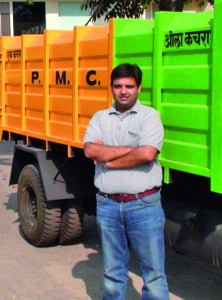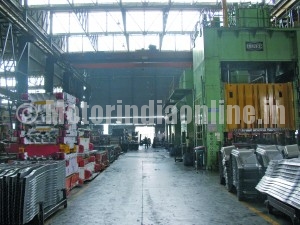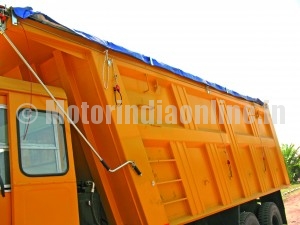Pune-headquartered automotive solution provider targeting a four-fold turnover in five years with an investment of Rs.90 crores

Circa 1933. That was the year Jainarayan Gupta set up his maiden Tata truck dealership in the cool climes of Dehradun. Perhaps he would have never dreamt that almost half a century later he would be cementing his relationship with the Tatas so deeply that his parivar had to get neck deep into manufacturing as well and set up his maiden production facility of making body fabrication to Pune, to be closer to the country’s numerouno heavy commercial vehicle manufacturer. Backward integration? Spot on.
Circa 1985 was the year KailashVahanUdyog Limited or KVUL came into existence at Dhanore village, situated on the Alandi-Markal Road in Khed district, 20 km away from the city of Pune, taking the name from founder Jainarayan Gupta’s son Kailash and paternal uncle of Raghav Gupta, in his 30s and holding the reins as Managing Director. “Trucking is the only business we understand. Day in, day out, we were financing as well as selling trucks. So, it is but natural for us to deepen our roots in this sphere,” avers Raghav. Amens, Upesh Kumar Goel, an ex-Tata veteran who later on has cottoned onto Kailash Gupta as advisor to guide the group. “When Tatas tell you to come along with us to Pune and help build bodies there, two things become crystal clear: primarily, its full confidence in your capability and secondly a secured business,” elaborates the salt-and-pepper haired and no-nonsense professional.

By the way, what’s KVUL’s business? Good question. By and large, truck manufacturers do not build the entire truck as we see them plying on Indian roads. They build chassis and get the body in which materials or passengers carried built by others thus paving way for the creation of the tribe labeled as ‘body builders’. These ‘business associates’ receive chassis and fabricate bodies as per customer (end user or OEM) specifications at their own manufacturing bases. In India, a peculiar situation has arisen with the mushrooming growth of roadside fabricators vis-à-vis organized players. In fact, the unorganized segment outnumbers others, thanks to motor maliks (fleet owners) preferring the unorganized segment to spend less by way of no sales tax and other related issues to be paid. “We have to make provision for 12.36 per cent excise duty and 12 per cent VAT (sales tax) when we bill our clients. That’s 25 per cent additional burden on end-user,” adds ShivamArren, an IIT-Varanasi alumni with an MBA thrown in from IIM-Indore, now wearing the hat of Vice President (Operations) at KVUL’s Pune plant as well as its Bilaspur facility where another company is body building under license from KVUL. Besides, the early 30s Kanporean, manages sales and marketing of the group’s joint venture with Rolfo of Turin, Italy for its foray into car and chassis carrier business (See Box: The Italian Job)

Though KVUL (Pune), spread across 21 acres, came into existence to assist Tatas to sell ‘complete solutions’ (read chassis with body built or fully built units) originally, today KVUL caters to a wide variety of players such as Ashok Leyland, Mahindra Navistar, Eicher, BharatBenz, JCB, Mahindra Construction Equipment, Piaggio, Bajaj (three wheelers) among others. In the process, the group is also engaged in dealership business at Kanpur, Dehradun, Bareilley, Jabalpur for trucks and cars of Hyundai, Toyota, Ford etc. Its focus is on automotive applications: cargo bodies, tippers, trailers, garbage compactors, troop carriers etc. The company has six plants at Pune, Bangalore, Chennai, Pant Nagar, Kanpur and Bilaspur. The Chennai plant near auto-hub Oragadam is set up to service BharatBenz near its own manufacturing facility and the Bilaspur production facility will make tipper trailers to cater to the needs of the mining belt, under license from KVUL. The JN group has yet another company under the name of Commercial Engineers and Body Builders (CEBBCO), based out of Jabalpur which is focused on tippers and plans to diversify into railway wagons as well.
Despite the cyclical nature of trucking business, KVUL has grown 10 times over the past 10 years with almost 35 to 40 per cent growth year on year. It posted a phenomenal 60 per cent growth last year (2011-12), thanks to unprecedented demand for tippers and notwithstanding competition from other players across India. The current year 2012-13 is unlikely to be so good. KVUL would be glad if it grows by 5 to 10 per cent. “It is a cyclical business and we were able to hang on to existing clientele and post a moderate growth this year,” admits Director (Finance) Hemendra Kumar Agarwal, who has spent past 25 years inside KVUL.
With the roster of clients that KVUL boasts of, the ride has been smooth but challenges are not absent. The biggest challenge is the availability of skilled manpower and then an ability to hold onto them, or retention if one may say so. Welders and painters are tough to recruit and retain. High attrition is part of life and training is an ongoing exercise. Like a revolving door, people come and people go. Is automation the final frontier? Maybe.
Challenges don’t demoralize KVUL top-brass. An investment of Rs.90 crores has already been sunk in keeping the long-term business prospects in mind. A Cathode Electro Deposition (CED) facility has sprung up as a value-add to its clients in Pune. Since common water cannot be used in this process, a demineralized water plant has also come up along with a 500 KVA genset to ensure uninterrupted power supply because, once the process is on, “you simply can’t switch off”. Plus, KVUL has gone in for automated route for two reasons: to achieve consistent quality and tackle manpower shortage. However, it is not the ‘robotic’ route. Functions such as spot welding has been converted into specialized purpose machined automation. Engineers are still needed, but low level jobs are being eliminated.
Like an OEM, KVUL pays huge attention to welding and painting processes. While arc welding is strictly forbidden, metal innard gas welding is the choice, that too with argon mixed with CO2. Why CO2? To avoid oxidization. Piped gas, not gas tanks is the norm within KVUL precincts. Why go this extra mile? To create greater protection to the cargo body through stronger weld. By the way, a majority of body builders resort to arc welding which is considered to be very primitive. Argon is expensive, but the customer delight is unmeasurable, avers Shivam. Similarly, painting receives lot of attention. Cargo bodies are pre-treated, dipped in paint tanks, baked etc. because ‘paint determines life’ of vehicles.
KVUL’s penchant for perfection and quality is second to none. Any doubts? Hear this out. Corrosion is the biggest challenge for fleet owners and therefore OEMs would love to do anything to satisfy this need. It is no secret that trucks are used for rugged applications, unlike passenger vehicles. Painting is obviously the route to tackle this menace. What’s OEMs concern or wish is KVUL’s as well. Sensing that abrasive surface is a ‘must’ for the paint to stick on, the steel panels are ‘short blasted’ – small pellets are fired at a high speed. However, if the steel used is less than 1.2 mm, shortblasting is not recommended and then in that case, these steel panels go through the seven tank phosphating route.

Meanwhile, the advent of higher-end technology has enabled spray phosphating as well. Mahindra multi axle bodies at KVUL are ‘spray phosphated’. In coastal areas, truck bodies corrode fast due to salty environment. OEMs are comfortable with 240 hours of salt spray test, that is, steel panels used in bodies should withstand 240 hours of salt water dip. Nano technology, slightly expensive, gives OEMs nothing less than 1,000 hours of salt spray test! Garbage compactor users, used by municipal bodies, prefer this nano-treated vehicle bodies.
KVUL is also going in for cold rolled steel mill as further extension of backward integration at an estimated cost of Rs. 2crores and to help OEMs to keep cost as low as possible. Nonetheless, 1,800 bodies a month will make this project economically viable. “We see this facility helping our clients immensely and therefore we are confident of getting those numbers,” adds advisor Goel.
Rs.90 crore is no small amount to sink in. Finance director confirms that the entire investment has come in from internal accruals. “We don’t see a need for an initial public offering (IPO) at this moment. We can manage,” says he. “We are future ready with requisite infrastructure ready to cater to the needs of all our clients,” explains Shivam. Adds Raghav Gupta: “When we identified areas for investment, obviously we had taken a long term perspective and the way things are unfolding on the Indian scenario. Body building is undergoing a tremendous change here. Getting into niche segments is gaining popularity. That explains our Rolfo engagement.” Chips in Goel: “Our product mix and geographical location are also strategically planned and placed.”
The journey that has its beginnings in 1933 in Dehradun for this group has managed well given its excellent rapport with top-notch players. It is not found wanting in cashing in on newfound business opportunities. Above all, its courage to take a call on its future and talking boldly of a four-fold increase in its turnover over the next five years with right kind of strategic investment is worthy of emulation.